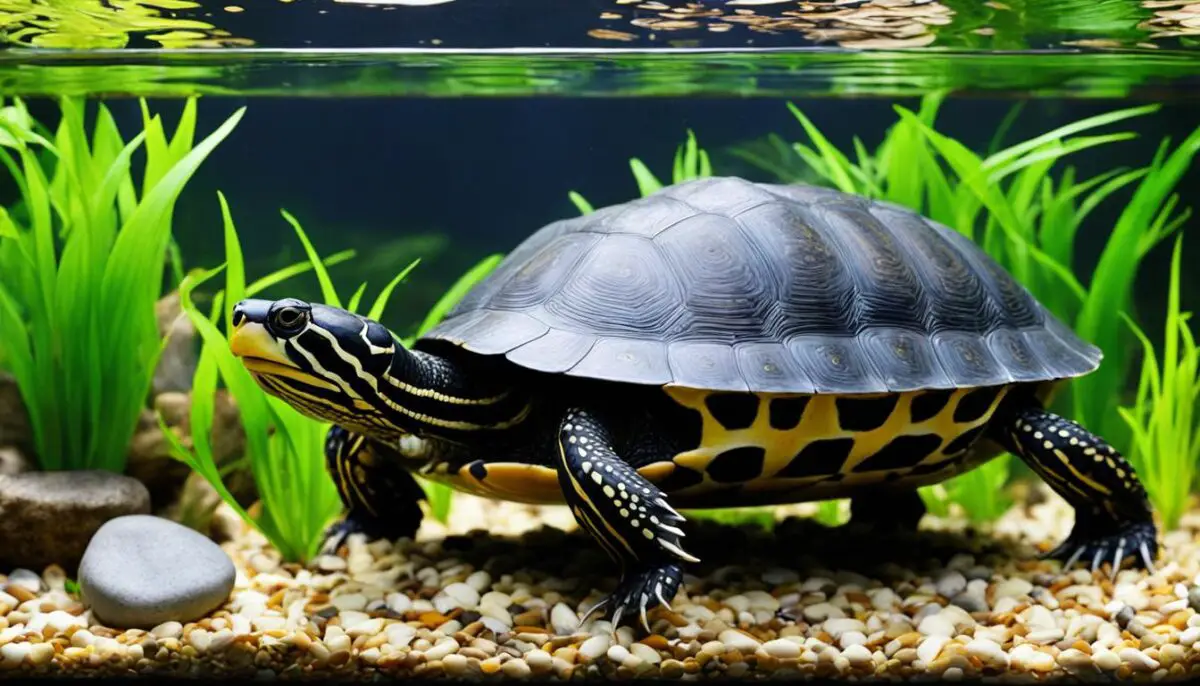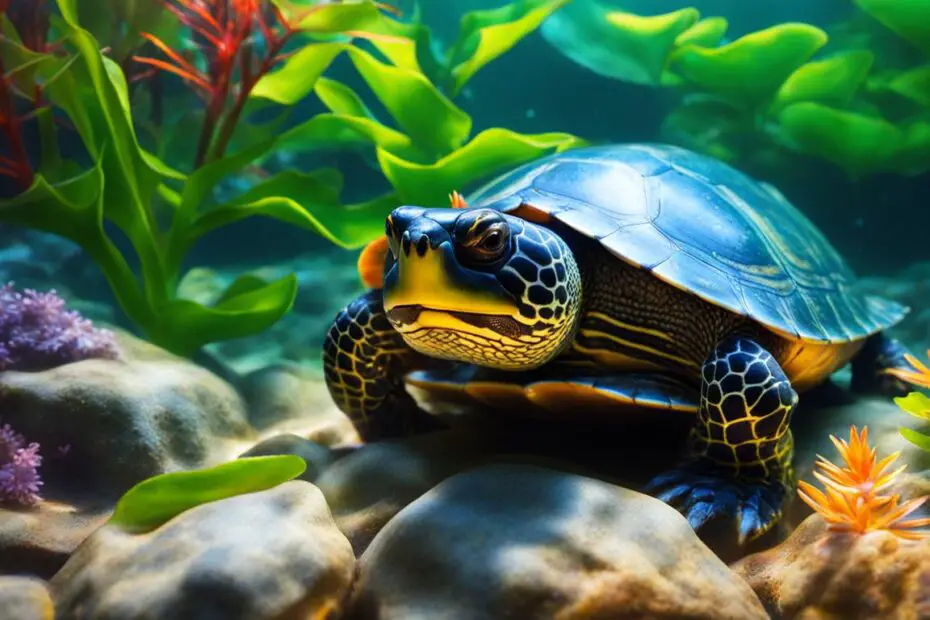Welcome to the fascinating world of the painted shell turtle! Also known as Chrysemys picta, this captivating reptile is found throughout North America, captivating nature enthusiasts with its vibrant and artistic shell. In this section, we will delve deeper into the origin and habitat of painted turtles, as well as their unique appearance and behaviors.
Key Takeaways
- The painted shell turtle, also known as Chrysemys picta, is a captivating reptile found throughout North America.
- Painted turtles can be found in various locations across North America, adapting to freshwater lakes, ponds, rivers, and marshes.
- When bringing a painted turtle home, create a suitable environment with a spacious tank, clean water, a basking area, a balanced diet, and hiding spots.
- Painted turtles have a distinctive appearance with a dark olive to black shell and vibrant red and yellow markings.
- They are active during the day, enjoy basking in the sun, and retract their heads and legs into their shell when threatened.
Where They Originate From
Painted turtles, scientifically known as Chrysemys picta, are native to North America. They can be found across various regions, spanning from Canada to Mexico. These charming reptiles have adapted to a versatile range of habitats, making them widespread throughout the continent.
Their habitat preference includes freshwater lakes, ponds, rivers, and marshes, where they can find abundant food sources and suitable nesting sites. Painted turtles are skillful swimmers, but they are not exclusively water-dwelling creatures.
“Painted turtles have the remarkable ability to regulate their body temperature by basking in the sun,” says Dr. Emily Collins, a herpetologist at the North American Wildlife Conservation Society. “They often climb onto logs and rocks along the water’s edge to soak up the warmth of the sun’s rays.”
This behavior not only helps them maintain their ideal body temperature but also provides an opportunity for thermoregulation and digestion. Additionally, basking in the sun allows the painted turtles to showcase their vibrant colors, making them a sight to behold.

Painted turtles have adapted well to human-altered habitats, such as urban parks and residential ponds, as long as there is suitable vegetation and access to water. Their ability to thrive in different environments makes them one of the most abundant turtle species in North America.
| Painted Turtle Origin | Painted Turtle Habitat | North American Painted Turtle |
|---|---|---|
| Native to North America | Freshwater lakes, ponds, rivers, marshes | Widespread across the continent |
| Can be found from Canada to Mexico | Adapts well to human-altered habitats | One of the most abundant turtle species |
Painted turtles are a testament to the adaptable nature of wildlife, as they have successfully established themselves in various ecosystems, enchanting both nature enthusiasts and researchers alike.
Choosing and Buying
When bringing a painted turtle home, it is important to create a suitable environment for them. Providing the right setup will ensure their well-being and happiness. Here are some essential factors to consider for a successful painted turtle tank setup, along with guidelines for their care and diet.
Tank Setup
Creating a spacious and comfortable tank for your painted turtle is crucial. Remember, these turtles can grow up to 7-8 inches in shell length, so a larger tank is always better. The minimum recommended tank size for one painted turtle is a 40-gallon capacity. If you plan to keep multiple turtles, a larger tank or outdoor pond would be more appropriate to accommodate their needs.
Your painted turtle tank should have clean, warm water maintained at a temperature between 75-85°F (24-29°C). The water depth should be at least double the length of your turtle’s shell to allow for swimming and diving. Ensure that the temperature is consistent by using a reliable aquarium heater.
In addition to water, your painted turtle will need a basking area where they can dry off and soak up heat. Use a floating platform or rocks that emerge above the waterline for this purpose. Place a heat lamp above the basking area to maintain a temperature of 90-95°F (32-35°C). This will provide your turtle with the necessary warmth to regulate their body temperature.
Care and Diet
Caring for a painted turtle involves more than just providing a suitable tank. You should also pay attention to their diet and overall well-being.
Diet: Painted turtles are omnivorous and require a balanced diet. Include commercial turtle pellets as the primary food source, as these contain essential vitamins and minerals. Offer them a variety of leafy greens such as kale, spinach, and dandelion greens as part of their diet. Additionally, provide occasional treats like earthworms, crickets, or small fish. It is crucial to avoid feeding them excessive protein-rich food, such as meat or insects, as it can lead to health issues.
Veterinary Check-ups: Regular visits to a reptile veterinarian are vital to ensure your painted turtle’s health is monitored. They can provide guidance on diet, tank conditions, and overall care. Consult your veterinarian for personalized recommendations tailored to your painted turtle’s specific needs.
Handling: When handling your painted turtle, be gentle and avoid gripping them tightly. Always wash your hands before and after handling to prevent the potential spread of bacteria or diseases.
Hiding Spots: Providing hiding spots in the tank, such as logs, plants, or caves, is essential for your turtle’s security. These spots allow them to retreat and feel safe when they want to rest or escape potential stressors.
Remember, each painted turtle is unique, and their care requirements may vary slightly. Paying attention to their behavior and adjusting the tank setup or diet accordingly will help ensure their well-being.

| Essential Components for Painted Turtle Tank Setup | Quantity |
|---|---|
| Large tank with secure lid | 1 |
| Aquarium heater | 1 |
| Basking area with heat lamp | 1 |
| Water filter | 1 |
| Substrate (river rocks or aquarium gravel) | Enough to cover the tank bottom |
| Decorations and hiding spots | Varies based on tank size |
| Commercial turtle pellets | As per feeding requirements |
| Leafy greens (kale, spinach, dandelion greens) | Varies based on feeding requirements |
| Turtle treats (earthworms, crickets, small fish) | Occasional treats as per diet |
Appearance and Behavior
Painted turtles are visually striking creatures, known for their unique appearance and fascinating behavior. Their distinctive shell colors and patterns make them stand out among other turtle species.
The painted turtle’s shell ranges from dark olive to black, providing a striking contrast to the vibrant red and yellow markings on their bodies. These bold colors serve as a form of camouflage, helping them blend into their natural habitat. The intricate patterns on their shells resemble an artist’s masterpiece, adding to their allure.
When it comes to behavior, painted turtles are graceful swimmers. They glide through water effortlessly, their limbs propelling them with precision. However, their captivating behavior becomes even more apparent when they feel threatened.
“When a painted turtle senses danger, it retreats into its shell.”
Known for their unique defense mechanism, painted turtles can retract their heads and legs into their shells, keeping themselves protected from potential harm. This behavior showcases their adaptability and survival instincts in the face of adversity.
Another interesting aspect of their behavior is their affinity for basking in the sun. Painted turtles are diurnal, meaning they are most active during the day. They enjoy soaking up the warmth of the sun, often seen resting on logs or rocks near the water’s edge.
Conclusion
In conclusion, the painted shell turtle is a fascinating reptile with a vibrant and artistic shell. These turtles can be found throughout North America, from Canada to Mexico, and have a wide habitat range that includes freshwater lakes, ponds, rivers, and marshes. They are not only excellent swimmers but also enjoy basking in the sun on logs and rocks.
When owning a painted turtle, it is crucial to provide them with the appropriate environment, care, and diet. They require a spacious tank with clean, warm water, a basking area with a heat lamp, and a diet consisting of commercial turtle pellets and leafy greens. Regular veterinary check-ups and proper handling are also essential for their well-being and health.
The painted turtle’s distinctive appearance, with its dark olive to black shell adorned with red and yellow markings, is truly captivating. They are known for their charming behaviors, such as retracting their heads and legs into their shells when feeling threatened. Active during the day, these turtles never fail to delight nature enthusiasts and provide endless opportunities to observe and appreciate their unique traits.
With their eye-catching appearance and adaptable behaviors, the painted shell turtle is undoubtedly a fascinating and cherished reptile. Their colorful and hand-painted shells make them stand out among other turtle species. Whether you are a beginner or an experienced turtle owner, the painted shell turtle will undoubtedly bring joy and wonder into your life.
FAQ
Are painted shell turtles and painted turtles the same species?
Yes, painted shell turtle and painted turtle refer to the same species, Chrysemys picta.
Can painted turtles live in different types of water bodies?
Yes, painted turtles can adapt to various freshwater habitats, including lakes, ponds, rivers, and marshes.
How should I set up a tank for a painted turtle?
To create a suitable environment, you’ll need a spacious tank with clean, warm water, a basking area equipped with a heat lamp, hiding spots, and proper filtration.
What should I feed my painted turtle?
A balanced diet for painted turtles includes commercial turtle pellets and leafy greens, such as lettuce, kale, and spinach.
How should I handle my painted turtle?
When handling a painted turtle, be gentle and avoid picking them up by their shell. Instead, support their body and avoid excessive stress.
Do painted turtles have any unique behaviors?
Yes, painted turtles are known for their graceful swimming abilities and their ability to retract their heads and legs into their shell when threatened.
What are the distinguishing features of a painted turtle?
Painted turtles have a dark olive to black shell with vibrant red and yellow markings, making them visually striking.

